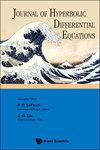On vanishing pressure limit of continuous solutions to the isentropic Euler equations
IF 1.1
4区 数学
Q4 MATHEMATICS, APPLIED
引用次数: 0
Abstract
The vanishing pressure limit of continuous solutions isentropic Euler equations is analyzed, which is formulated as small parameter [Formula: see text] goes to [Formula: see text]. Due to the characteristics being degenerated in the limiting process, the resonance may cause the mass concentration. It is shown that in the pressure vanishing process, for the isentropic Euler equations, the continuous solutions with compressive initial data converge to the mass concentration solution of pressureless Euler equations, and with rarefaction initial data converge to the continuous solutions globally. It is worth to point out: [Formula: see text] converges in [Formula: see text], while [Formula: see text] converges in [Formula: see text], due to the structure of pressureless Euler equations. To handle the blow-up of density [Formula: see text] and spatial derivatives of velocity [Formula: see text], a new level set argument is introduced. Furthermore, we consider the convergence rate with respect to [Formula: see text], both [Formula: see text] and the area of characteristic triangle are [Formula: see text] order, while the rates of [Formula: see text] and [Formula: see text] depend on the further regularity of the initial data of [Formula: see text].关于等熵Euler方程连续解的消失压力极限
分析了连续解等熵欧拉方程的消失压力极限,将其表示为小参数[公式:见文]至[公式:见文]。由于在极限过程中特性退化,共振可能引起质量集中。结果表明,在压力消失过程中,对于等熵欧拉方程,具有压缩初始数据的连续解收敛于无压力欧拉方程的质量浓度解,具有稀疏初始数据的连续解全局收敛于连续解。值得指出的是,由于无压欧拉方程的结构,[公式:见文]收敛于[公式:见文],而[公式:见文]收敛于[公式:见文]。为了处理密度[公式:见文]和速度空间导数[公式:见文]的膨胀,引入了一个新的水平集参数。进一步,我们考虑关于[公式:见文]的收敛速率,[公式:见文]和特征三角形的面积都是[公式:见文]的顺序,而[公式:见文]和[公式:见文]的速率取决于[公式:见文]初始数据的进一步规律性。
本文章由计算机程序翻译,如有差异,请以英文原文为准。
求助全文
约1分钟内获得全文
求助全文
来源期刊

Journal of Hyperbolic Differential Equations
数学-物理:数学物理
CiteScore
1.10
自引率
0.00%
发文量
15
审稿时长
24 months
期刊介绍:
This journal publishes original research papers on nonlinear hyperbolic problems and related topics, of mathematical and/or physical interest. Specifically, it invites papers on the theory and numerical analysis of hyperbolic conservation laws and of hyperbolic partial differential equations arising in mathematical physics. The Journal welcomes contributions in:
Theory of nonlinear hyperbolic systems of conservation laws, addressing the issues of well-posedness and qualitative behavior of solutions, in one or several space dimensions.
Hyperbolic differential equations of mathematical physics, such as the Einstein equations of general relativity, Dirac equations, Maxwell equations, relativistic fluid models, etc.
Lorentzian geometry, particularly global geometric and causal theoretic aspects of spacetimes satisfying the Einstein equations.
Nonlinear hyperbolic systems arising in continuum physics such as: hyperbolic models of fluid dynamics, mixed models of transonic flows, etc.
General problems that are dominated (but not exclusively driven) by finite speed phenomena, such as dissipative and dispersive perturbations of hyperbolic systems, and models from statistical mechanics and other probabilistic models relevant to the derivation of fluid dynamical equations.
Convergence analysis of numerical methods for hyperbolic equations: finite difference schemes, finite volumes schemes, etc.
 求助内容:
求助内容: 应助结果提醒方式:
应助结果提醒方式:


